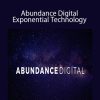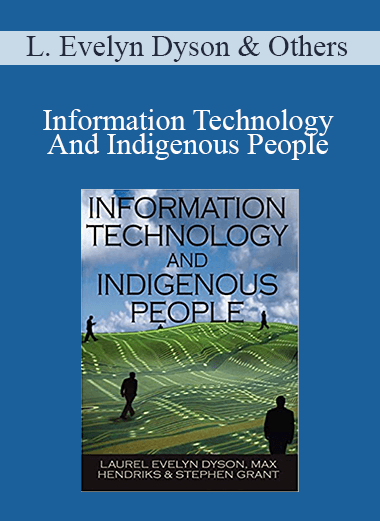Laurel Evelyn Dyson & Others – Information Technology And Indigenous People
$90.00 Original price was: $90.00.$30.00Current price is: $30.00.
Digital Download: You will receive a download link via your order email
Information Technology and Indigenous People provides theoretical and empirical information related to the planning and execution of IT projects aimed at serving indigenous people. It explores many cultural concerns with IT implementation, including language issues and questions of cultural appropriateness…
Information Technology And Indigenous People
By: Laurel Evelyn Dyson, Max Hendriks and Stephen Grant
Release Date: August, 2006
Format: Ebook (PDF)
Description:
Indigenous people around the world are becoming more interested in information technology because they see it as a way to preserve their traditional cultures for future generations as well as a way to provide their communities with economic and social renewal. However, the cost of the new technologies, geographic isolation, and a lack of computer literacy have made it difficult for indigenous people to adopt IT.
Information Technology and Indigenous People provides theoretical and empirical information related to the planning and execution of IT projects aimed at serving indigenous people. It explores many cultural concerns with IT implementation, including language issues and questions of cultural appropriateness, and brings together cutting-edge research from both indigenous and non-indigenous scholars.
Table of contents:
- Chapter 1 Portals and Potlach (pages 1-13)
- Chapter 2 Indigenous Peoples and the Cultural Constructions of Information and Communication Technology (ICT) in Latin America (pages 14-26)
- Chapter 3 Indigenous Knowledges and Worldview: Representations and the Internet (pages 27-29)
- Chapter 4 Kaitiakitanga and Health Informatics: Introducing Useful Indigenous Concepts of Governance in the Health Sector (pages 30-51)
- Chapter 5 ICTs for intercultural Dialog (ICT4ID) (pages 52-54)
- Chapter 6 ICT and the Orang Asli in Malaysia (pages 55-57)
- Chapter 7 My Life With Computers on a Remote Island (pages 58-60
- Chapter 8 How Computers Came Into My Life (pages 61-64)
- Chapter 9 Developing Culturally Inclusive Educational Multimedia in the South Pacific (pages 65-79)
- Chapter 10 Learning to Internet Bank (pages 80-92)
- Chapter 11 Can Information Communication Technological Tools Be Used to Suit Aboriginal Learning Pedagogies (pages 93-104)
- Chapter 12 Instructional Design and Technology Implications for Indigenous Knowledge: Africa’s Introspective (pages 105-116)
- Chapter 13 Computer Technology and Native Literacy in the amazon (pages 117-119)
- Chapter 14 Toi Whatoranga: Maori and Learning Technology (pages 120-122)
- Chapter 15 Multimedia Curriculum Development Based on the Oval Tradition (pages 123-125)
- Chapter 16 The Indigenous Pre-IT Program (pages 126-131)
- Chapter 17 Problem-Based Online Learning in Indigenous Tertiary Education: Reflections on Implementation (pages 132-136)
- Chapter 18 Student Technology Projects in a Remote First Nations Village (pages 137-140)
- Chapter 19 Draw-Talk-Write: Experiences and Learning with Indigenous Australians that are Driving the Evolution of Word Recognition Technology (pages 141-145)
- Chapter 20 Ara Irititja: Towards Culturally Appropriate IT Best Practice in Remote Indigenous Australia (pages 146-158)
- Chapter 21 Digital Songlines: Digitising the Arts, Culture and Heritage Landscape of Aborignal Australia (pages 159-169)
-
Chapter 22 The Use of Information and Communication Technology for the Preservation of Aboriginal Culture: The Badimaya People of Western Australia (pages 170-174)
-
Chapter 23 Indigenous Language Usage in a Bilingual Interface: Transaction Log Analysis of the Niupepa Web Site (pages 175-188)
- Chapter 24 Language, Identity, and Community Control: The Tagish First Voices Project (pages 189-191)
- Chapter 25 Towards an Indigenous Language Knowledge Base: Tools and Techniques from the Arwarbukarl Community (pages 192-196)
- Chapter 26 Ndjebbana Talking Books: A Technological Transformation to Fit Kuynibidji Social Practice (pages 197-199)
-
Chapter 27 A Talking Dictionary of Paakantyi (pages 200-204)
-
Chapter 28 Building the Dena’ina Language Alaska Archive (pages 205-209)
- Chapter 29 Ethnocomputing with Native American Design (pages 210-219)
-
Chapter 30 Cut from the Same Cloth: The United States Bureau of Indian Affairs, Geographic Information Systems, and Cultural Assimilation (pages 220-231)
-
Chapter 31 Representations of Tribal Boundaries of Australian Indigenous Peoples and the Implications for Geographic Information Systems (pages 232-244)
-
Chapter 32 E-Community-Based Tourism for Asia’s Indigenous People (pages 245-256)
- Chapter 33 Computerised Tests of Brain Function for Use with Indigenous People (pages 257-259)
-
Chapter 34 Alliance Project: Digital Kinship Database and Genealogy (pages 260-265)
- Chapter 35 Agreements Treaties and Negotiated Settlements Database (pages 266-271)
-
Chapter 36 The Diffusion of New Technologies: Community Online Access Centre in Indigenous Communities in Australia (pages 272-285)
- Chapter 37 Wireless Applications in Africa (pages 286-294)
-
Chapter 38 UHF-Based Community Voice Service in Ngannyatjarra Lands of Australia (pages 295-297)
- Chapter 39 Cape York Digital Network (pages 298-301)
- Chapter 40 Redfern Kids Connect (pages 302-304)
-
Chapter 41 Community Computing and Literacy in Pascua Yaqui Pueblo (pages 305-309)
-
Chapter 42 Reunification of the Wendat/Wyandotte Nation at a Time of Globalization (pages 310-313)
- Chapter 43 Future Directions (pages 314-315)
- Glossary
- About the Authors
- Index
Authors:
Laurel Evelyn Dyson, Ph.D., is a lecturer in information technology at the University of Technology, Sydney, Australia, where she is one of the founders of the Indigenous Participation in Information Technology Project. As part of this project, Dr. Dyson led the successful introduction of the first university information technology tertiary preparation course for Indigenous people in Australia. Having lived on the other side of the Digital Divide until a few years ago, her mission is to assist others to master the tools of the Information Age. In this role, her teaching has included computer education programs for Indigenous Australians, senior citizens, adult literacy students, and prisoners. In total, her experience in university and adult education spans a period of over two decades, with a focus on language, study skills, university preparation courses and lately information technology. She has published one book and a number of book chapters and research papers, has been interviewed 13 times about her research for radio and the press, and has had 33 reviews of her work in the media. Currently, she is leading the evaluation, for UNESCO, of their ICT4ID Project involving Indigenous people and information and communication technologies in Africa and Latin America.
Max Hendriks lectures in information technology at the University of Technology, Sydney, Australia, where he is also currently completing a master’s degree in internetworking science. He has been an educator for over 35 years and taught all grades from pre-school through to university postgraduate students, as well as holding senior executive positions in education. He is involved in the Indigenous Participation in Information Technology Project at the University of Technology, Sydney, and took an active role in the development and delivery of the university’s first Indigenous pre-IT program.
Stephen Grant holds an academic position at the University of Technology, Sydney, Australia, where he is in charge of mentoring Indigenous students in the Indigenous Participation in Information Technology Project. He was recently presented with a university Equity, Social Justice and Human Rights Award for his work in the program. He is one of a handful of qualified Indigenous IT professionals in Australia, with qualifications and industry experience in engineering and IT as well as in Indigenous affairs. Since joining the University of Technology, Sydney, he has added to his networking industry certification by becoming a qualified networking instructor as well as commencing a Master of Science in Internetworking, making him one of three Indigenous IT postgraduate students in Australia.
Get Download Laurel Evelyn Dyson & Others – Information Technology And Indigenous People at imcourse.biz today!
Delivery Method
– After your purchase, you’ll see a View your orders link which goes to the Downloads page. Here, you can download all the files associated with your order.
– Downloads are available once your payment is confirmed, we’ll also send you a download notification email separate from any transaction notification emails you receive from imcourse.biz.
– Since it is a digital copy, our suggestion is to download and save it to your hard drive. In case the link is broken for any reason, please contact us and we will resend the new download link.
– If you cannot find the download link, please don’t worry about that. We will update and notify you as soon as possible at 8:00 AM – 8:00 PM (UTC+8).
Thank You For Shopping With Us!





10 reviews for Laurel Evelyn Dyson & Others – Information Technology And Indigenous People
There are no reviews yet.